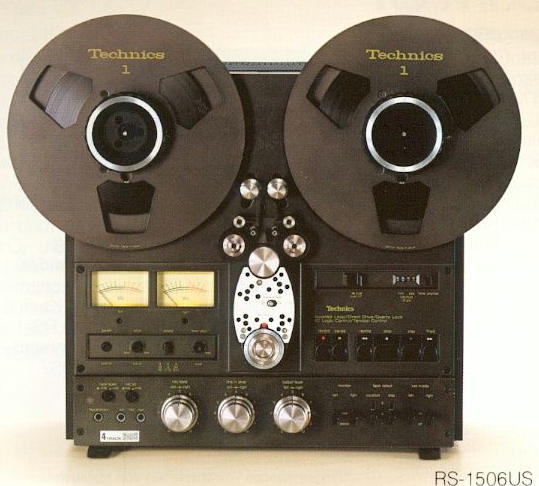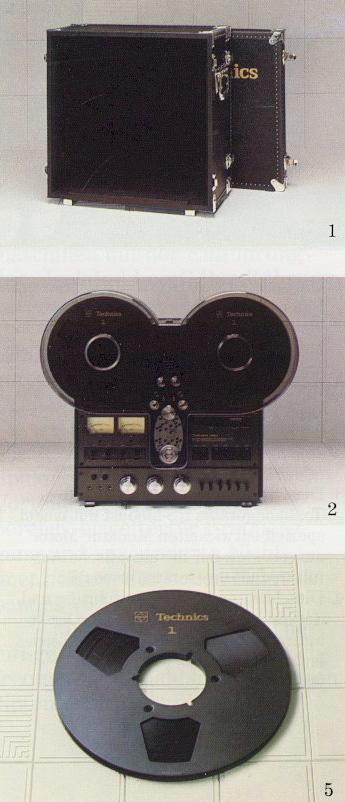Technics RS-1506 US
Data
General
- Manufacturer: Technics
- Model: RS-1506US
- Years of manufacture: 1977 to 1986
- Made in: Osaka, Japan
- Color: black
- Remote control: optional with RP-9690 (wired remote control) or RP-070 (infrared remote control)
- Power consumption: 120 W
- Dimensions: Width:456 mm, Height: 446 mm, Depth: 258 mm.
- Weight: approx. 25 kg
- Original price approx.: 2'988 DM
Option 2-track head mount RP-2224: 399 DM
- Option 4-track headstock RP-2422: 399 DM
Connections
- Number of outputs: 2
- Headphones: 80 mV/8Ohm
Line Out: 0.5 V (OVU)/at 22 kOhm or more
- DIN: No
- Number of inputs: 3
- Microphone: 0.25 mV (-72 dB)/4.7 kOhm
- Line In: 60 mV (-24 dB)/150 kOhm
- Trough Out: 60 mV (-24 dB)/150 kOhm
Technical Data
max.coil diameter: 26,5 cm
Drive: Direct-drive, collectorless DC motor with phase-locked quartz control for the tone shaft, two direct-drive, collectorless DC motors with tape tension control for the winding plates
- Heads: 4 tone heads (headstock: RP-2422)
- Tracks: 4
- Tape speeds: 9.5 cm/s, 19 cm/s, and 38 cm/s.
- Synchronous speed fluctuations:
- at 9.5 cm/s: 0.018% (WRMS) +/-0.035% DIN)
- at 19 cm/s: 0.03% (WRMS) +/-0.06% DIN)
- at 38 cm/s: 0.06% (WRMS) +/-0.12% DIN)
- Pitch fluctuations:
- Overall frequency response:
- at 9.5 cm/s: 20 - 15,000 Hz, +/-3 dB
- at 19 cm/s: 20 - 25,000 Hz, +/-3 dB
- at 38 cm/s: 30 - 30,000 Hz, +/-3 dB
- Signal-to-noise ratio:
- extraneous signal-to-noise ratio (pickup level = 3% total harmonic distortion):
- at 9.5 cm/s: 64 dB
- at 19 cm/s: 66 dB
at 38 cm/s: 66 dB
- Total harmonic distortion (0 VU): 0.8%.
- Equalization:
- crosstalk attenuation at 1 kHZ in stereo mode: 50 dB
- Cancellation attenuation: at 19 cm/s: 65 dB
- Premagnetization and extinction frequency: 120 kHz
Special Features
- Speed fine adjustment (record/playback): +/-6%.
- Four-digit tape counter, at 38 cm/s display of real time, at other tape speeds must be converted.
- "Isolated Loop" tape guide
Accessories (see pictures below and under RS-1700)
- RP-9100 flight case (1)
- RP-9110 Hard plastic dust cover to put on when reels are mounted (2).
- RP-9120 Wooden side panels (Rio rosewood, veneered, thickness of side panels: 3 cm)
- RP-9130 Brackets for shelf mounting (3)
- RP-9690 Cable remote control for RS-1500US and RS-1506US (4)
- RP-9170 Cable remote control for RS-1700
- RP-070 Infrared remote control with receiver and transmitter (see RS-1700)
- RP-10A 26.5 cm aluminium empty reel (5)
- RP-2224 half-track headstock (6)
- RP-086 Battery adapter for 24 V DC operation
Remarks
- The machine is not EE-band suitable!
- Technically, the machine is identical to the RS-1500US. Audio head carrier on the RS-1500US is the RP-2224 (2-track record playback/4-track playback). On the RS-1506US, the audio head mount is the RP-2422 (4-track record/playback/2-track playback). Both headstocks can be interchanged at will between the two machines by loosening three screws. The RP-2224 and RP2422 headstocks will also work on an RS-1700, in which case the autoreverse function is disabled.
Typical signs of age:
- Worn brake pads. The felt pads on the rewind motor brakes are usually worn and the tape throws loops when you switch from rewind mode to play mode. The looping causes the key control to shut down and cannot be used again until the tape is retightened. You can remedy this by replacing the old felt brake pads with suede. How to do this is described in detail at [Tips for repairing Technics RS tape machines].
- Belt counter drive squeal. The drive pulley of the tape counter belt causes loud squeaking noises when rewinding. These squeaking noises disappear if you oil the axle of this drive pulley.
Worn out springs. If the machine has been standing around for years with the belt tensioned, the springs of the deflection pulleys are worn out. The machine will then no longer switch off when the belt has been unwound, as the deflection pulleys are no longer pulled completely upwards. The only remedy is to replace the springs. In the black plastic caps of the toggle switches for monitor, tape select and rec mode there are small metal springs to push on and fix the caps. Over the years, the plastic becomes brittle and bursts, causing the springs to push the plastic apart and the caps to fall off. Burst plastic caps can be repaired by gluing them together with 2-component glue and then putting tight black heat shrink tubing over them and heating it with hot air. Without the shrink hose, the glued plastic caps will not hold in the long run, no matter which glue you use. As a replacement for the plastic caps, you can also use aluminum caps from old Pioneer units (SA-XXXX or SX-XXXX) that fit on the switch tabs. See Image: SA-300K.
- Spare parts and accessories are no longer available from Panasonic or Technics.
- The AC power supply of the European version is switchable from 220V/240V to 110V/125V 50/60Hz. The American version is only designed for 110V/125V, but can also be operated on 220V/240V mains via an external transformer (so-called stepdown converter). The only important thing about such a converter is that it can handle the power consumption of the machine.
- Sending such a machine is a very delicate matter due to its heavy weight, as postal or parcel services are not exactly squeamish about such packages. I therefore recommend a personal delivery, even if you have to drive a few kilometers. Well packed, the Technics will even survive a trip across the pond. However, it is necessary to cover the front, back and sides with sufficiently thick polystyrene sheets. If the machine is only wrapped in crumpled up newspapers and styrofoam chips, the feet of the back or bottom panel or the switches, knobs or even the headstock on the front will inevitably punch into the machine when the package is thrown somewhere.
- Matching equipment from Technics:
- Other models in the same series:
- Technics_RS-777
- Technics_RS-10A02
- Technics_RS-1500_US
- Technics_RS-1500_S4
- Technics_RS-1506_US
- Technics_RS-1700
- Technics_RS-1800
Pictures
- Accessories: 1: Flight case RP-9100, 2: Dust cover RP-9110, 5: 26.5 cm aluminum coil RP-10A.
Reports
Here are a few repair reports on faults with the machine, with the request to add them if anyone has ever had problems with the machine:
- Instructions for disassembling and cleaning the switches: switch-problems
- Defect in the control of the winding motors. Recognizable by coils running unevenly or stopping. Possible cause see here: Technics RS-1506US and here: Technics RS-1506 US
- IC Logic Control button control stops working. Possible cause see here: A Real Recorder
- For other general reports on Technics tape machine buying tips, care and repairs, see here: [RS-1500US]
- Mackern.de - Read Hifi Technics RS 1506US Mackern.de Read Hifi Technics RS 1506US]
Links
- Promotional brochure for the Technics RS-1700, RS1506US and RS-1500US as a pdf file in color: Technics RS-1700, RS1506, RS-1500
- Operating Instructions (free pdf file): Technics Tape Deck RS-1500US RS-1506US Operating Instruction
- Technics RS tape machines and accessories: The Vintage Knob
- Silver RS-1700: Japanese Page
- Oliver's Technics Tape Machine Collection
- There's no accounting for taste, at least the Black Magic doesn't look that bad Modified Technics tape machines Silver plating the entire front panel of an RS-1700 is said to cost just under $1000.

